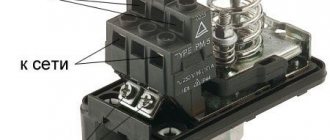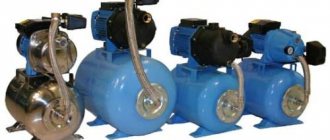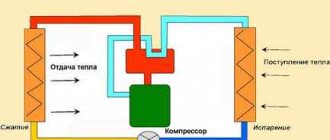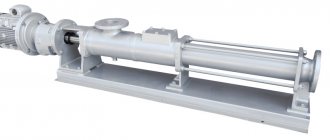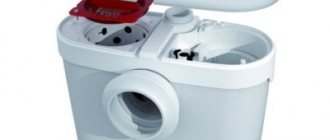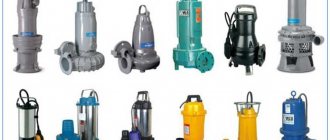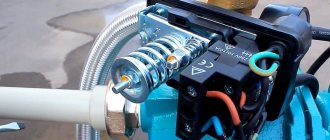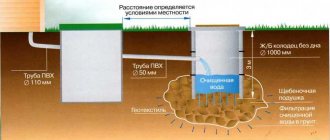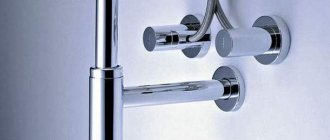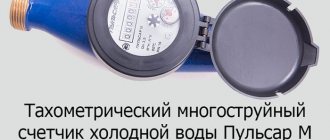To install effective autonomous water supply systems in country cottages, private houses and summer cottages, self-priming water pumps are needed. From the name it follows that this equipment is capable, being at a short distance from the source of water intake, to lift liquid from the depth, passing it “through itself”. The models produced by manufacturers differ in purpose and in a number of technical characteristics that need to be studied when choosing a pump for domestic use. Quite often, self-priming pumps in autonomous country water supply systems come together with a storage or membrane pressure tank. True, this type of equipment is already called a pumping station.
This video clearly shows the principle of operation of a household self-priming pump, which is capable of taking liquid from a container using a hose and pumping it to the right place.
What are the benefits of self-priming pumps?
Self-priming pumps are a real godsend for owners of wells and boreholes who decide to install an autonomous water supply system in their country house. These compact units have reliable protection against dry running.
When first started, a certain amount of water, provided by the design, is poured into the pump, which remains inside the housing even if there is no liquid in the water supply completely. In this way, the designers have significantly increased the wear resistance of the equipment.
Pumps of this type are very often installed in domestic pumping stations. They operate on the principle of drawing in and passing water through themselves, and are able to maintain a stable operating pressure in the water supply system. Due to their reliability and high performance, the units are actively used both in everyday life and for industrial needs.
Application area
The main advantage of any self-priming pump is its durability. In addition, the device is practically independent of service conditions. The industry produces both stationary and mobile pumps, which allows expanding the scope of their application.
The equipment easily copes with pumping clean water and viscous liquids. In this case, the operating temperature should not exceed +35 degrees. Although for special products this figure is increased to one hundred degrees Celsius.
In domestic conditions, the device is used for pumping water from shallow wells for water supply or drawing water from open reservoirs for watering beds. The pump copes well with both tasks.
In industry, pumps have the widest application - pumping fuel oil and diesel fuel from tanks, salt water and waste water. The units are not afraid of water with small inclusions of silt, sand and dirt. Therefore, powerful production models are successfully used for pumping out the contents of sewage pits or draining small private reservoirs and swimming pools.
The only drawback of a self-priming pump is its working depth of up to 8-10 meters. It will not be possible to lift water from deeper reservoirs or wells with such a pump. It is not immersed in water, but is installed on the surface. Injection is carried out through a hose, so the capabilities of the technology in terms of deep use are somewhat limited.
Tempting characteristics for home use are:
- possibility of installation outside the water supply source - can be mounted on the head of a shallow well with technical water, in a coffered chamber, technical extension or in the basement of a residential building;
- ease of maintenance - all important components are located on the surface;
- low cost of the unit - structural steel is used;
- powerful motor - there is enough space for its installation in the housing, because this is not a narrow cylindrical deep-well pump.
Main types
There are several main types of self-priming pumps, depending on the design features.
Centrifugal pumps consist of a casing in the shape of a snail (it must always be filled with water) and a motor with a disk in the form of an impeller (that is, having special propeller blades). The impeller at high speeds creates a vacuum in the housing, which allows the pump to draw in liquid.
Vortex-type pumps are capable of operating not only with liquid, but also with air. They are not afraid of dry running. Instead of an impeller, such pumps are equipped with a special wheel (impeller), which draws air into the housing and mixes it with the incoming liquid. Excess air is removed through a separate valve. Air also contributes to the development of vacuum and the absorption of liquid.
With ejector . Units of this type operate on the same principles as vortex pumps. However, the ejector allows you to make a fence from a depth of 15 to 30 meters, significantly increasing the power of the device (the standard is 8-10 meters). Such pumps are characterized by increased noise. There are models with remote ejectors that are installed outside the living space, thereby solving the noise problem.
Methods of use
Pumps operating on the centrifugal principle can be used for installation both on the surface and directly in water. Manufacturers produce models of both types.
Experts recommend surface models to provide temporary (seasonal) water supply. They are easy to maintain and install. If necessary, such a pump can be easily dismantled and stored or moved to another location.
And submersible units are considered ideal equipment for an autonomous water supply system (including those used for working in wells up to 30 meters deep). They are also indispensable for long hours of watering, draining a swimming pool or a flooded basement.
Operating principle
Any of the self-priming pumps operates due to the vacuum that occurs in the housing when the electric motor is running. There are two holes on the body - inlet and outlet.
The first is located in close proximity to the blades (impeller), rotating due to the engine generating torque on the shaft. The second is located at the end of the body - water enters here under pressure.
The centrifugal force that occurs when the impeller (or disk for vortex-type models) rotates creates a vacuum that allows water to be drawn in through a hose located in the water source.
The housing of centrifugal type models is pre-filled with water. Vortex pumps operate by sucking in air, so the chamber of the device is not filled with water before the first start.
The devices work equally well with both clean and polluted (turbid) water mixed with silt and sand. To work with very dirty water, special models are produced, equipped with a protective grille that filters large particles of dirt and impurities. Such pumps are designed for pumping feces or draining wells, boreholes, swimming pools, and basements.
What to give preference to?
There is no single universal advice for choosing a self-priming pump. Recommendations can be summarized as follows:
Centrifugal devices have large dimensions and are characterized by almost silent operation. Their disadvantages include low productivity and the ability to work with a depth of no more than 8-10 meters. This is a good choice for indoor installation and connection to a shallow well, as well as a seasonal option for watering beds using water from a river or lake.
For working with medium-depth wells, a vortex pump is the best choice. It is more powerful, works with a depth of up to 15, and with the existing ejector, up to 30 meters. Such a pump can be installed inside a well by immersing it in water (special submersible models).
Model overview
“Sprut” is produced by the Ukrainian trademark of the same name. This is a centrifugal type submersible pump. Works when completely immersed in water.
Advantages:
- small dimensions - fits into a well with a diameter of 8 to 16 centimeters;
- reliability.
Flaws:
- only works at a depth of 15 meters;
- designed to supply clean water without foreign impurities.
The average market price is from 7,800 to 14,000 rubles, depending on the model.
The Italian Pedrollo PKm 80 is a typical example of a vortex type surface pump. Working depth up to 7 meters. Used for watering, irrigation and water supply from shallow wells.
Advantages:
- long service life;
- reliability of the design;
- low energy consumption.
Flaws:
- cannot be used at great depths.
Average cost from 10,000 rubles.
Grundfos JPBasic 2 from the Danish manufacturer of the same name is designed for work on surfaces . Operates on the centrifugal principle. Can be used as the main unit for a pumping station.
Advantages:
- low electricity consumption;
- reliable cast iron body;
- Possibility of pumping water from an open reservoir.
Flaws:
- cannot be used at a depth of more than eight meters.
Price from 10,200 rubles.
Vitals aqua 4DV is produced by a Latvian company of the same name. It is a vortex type submersible pump. Capable of delivering up to 51 liters of water per minute.
Advantages:
- power;
- installation in a well up to 70 meters deep (which is a record in this class of pumps);
- low electricity consumption.
Flaws:
- difficulty in maintenance (equipment must be removed from the well).
Market price from 14,000 rubles.
Source: greenologia.ru/eko-zhizn/sistemy/
Characteristics
Main characteristics of self-priming devices depending on the power of the model:
Possible pump characteristics.
- Lifting depth (maximum distance from the pump to the level of the pumped liquid) – from 7 to 30 m.
- Discharge height (the maximum distance from the device to the mark to which it is capable of lifting water vertically upward) – from 10 to 64 m.
Pumps have different maximum temperatures of the working medium, performance, and work with different types of liquids - not all self-priming devices are suitable for water; there are models that can only work with clean water.
Operating principle of a self-priming pump: technical features
A self-priming pump is a type of surface pump that is used to supply water from wells and reservoirs, as well as to maintain pressure in water supply systems.
Self-priming pumps are available with and without an ejector. The ejector can be located either inside the pump or externally.
Self-priming pumps with a remote ejector are capable of lifting water from a depth of more than 10 meters, however, they have their drawback - due to the remote ejector, they are not suitable for wells with a small diameter.
The operating principle of an ejector pump is as follows: the pumped liquid in the pump is divided into two parts: one part is supplied to the discharge pipe, and the other is recirculated by the ejector. This creates a vacuum and promotes the absorption of liquid, which is enhanced by the operation of the ejector.
A mandatory requirement for self-priming pumps with an ejector is the tightness of the system.
Self-priming pumps without an ejector operate using a hydraulic device (one or more impellers). Such pumps are quieter, but the lifting depth is less (about 8 meters).
The principle of operation of a self-priming pump without an ejector is as follows: the impeller (or wheels), rotating, pushes the incoming liquid from the center and creates a vacuum, which leads to further suction.
There are two types of self-priming pumps: vortex and centrifugal. You can read more about centrifugal pumps in the article: Centrifugal pump and its principle of operation. You can learn more about the operating principle of vortex pumps on the page Vortex pumps Sprut.
You can get acquainted with the models of centrifugal pumps on the “Surface Pumps” website page. You can get advice on selecting and purchasing a pump for water supply to your home or site from a qualified engineer by calling the following numbers:
044 206-2096
Source: nasosvdom.com.ua/-/info/samovsasyvajuwij-nasos
Correct installation of the suction line
The suction line is the pipeline through which the liquid moves towards the surface pump. This pipeline is connected to the inlet pipe. The shorter the length of this line, the better. Before entering the unit, there must be a straight section of at least 2 pipe diameters in length. Most of the line is most often located vertically and ends at the bottom of a well, well, pit, or tank. The pipeline is made without sharp transitions with a minimum number of joints and bends. Connections must be tight. A slope of at least 5 mm per 1000 mm is required.
A bottom check valve is installed at the liquid inlet into the pipe: without it, when pumping is stopped, the working medium flows back down under the influence of gravity, air pockets form in the pipeline, and the pump operates in dry running mode, which leads to its rapid breakdown. In the operating instructions for the device, the manufacturer indicates the minimum distance from the bottom to the entrance to the suction line and the minimum length of the line from the check valve to the level of the liquid surface.
Self-priming water pumps: types, operating principles, operating recommendations
Self-priming pumps are a special type of surface equipment designed to increase the working life. Their moving parts are always cool, seals are not damaged, and the motor operates flawlessly. However, due to the large assortment, it can be difficult to settle on a suitable model. Do you agree?
Everything you need to know about self-priming water pumps can be found on our website. We have described in detail the principle of the design and operation of units of this type, and the differences in design are given. The information we provide will help you make an informed purchase.
We described in detail the different options for self-priming pumps and provided recommendations for operation. Useful photo and video applications will help you deepen your knowledge.
Features of self-priming units
When purchasing a unit for use in a suburban area, you should analyze a number of factors that determine the desired category.
These include:
- source depth;
- distance from source to home;
- pressure level;
- quality of supplied water;
- water consumption.
Typically, the listed data is taken into account when calculating the performance of the device, but they are also useful when choosing a pump based on the type of suction.
There are self-priming and normally priming devices. The difference lies in the design that regulates the refilling process if air gets into the system.
Pedrollo self-priming pump
A sample of a self-priming pump - Pedrollo PLURIJET, designed to move and lift clean water from sources from a depth not exceeding 9 m, nominal pressure up to 120 m, flow - 200 l/min (12 m3/hour)
Normally suction pumps include submersible and semi-submersible pumps, the operation of which occurs if the liquid from the source moves into the working compartment by gravity. When air enters, automatic protection against “dry running” is triggered and the operation stops, since the device cannot operate idle. The pump has to be restarted.
Self-priming pump operation diagram
Self-priming models are designed to remove air independently without human intervention. This happens due to design features: in the upper part of the working compartment there is a plunger through which air is removed. A check valve prevents him from returning.
Modern versions with built-in valves perform independent refilling, eliminating the need for constant monitoring of the equipment.
Features of the self-priming pump
The refilling process is also associated with the low lifting height of self-priming units - up to 9 m. It is important to ensure that the working chamber is constantly filled with water, and the shorter the supply line, the faster the process of moving water occurs.
Most often, self-priming pumps are part of a pumping station with a hydraulic accumulator, a suction pipe (or ejector), shut-off valves and instrumentation.
Correct installation of the suction line
When installing a water supply system, it is important not only to install a self-priming pump or pumping station, but also to install a suction line.
The pressure value (7-8 m) is calculated taking into account the height of the water rise and the parameters of the hydraulic resistance that occurs during the movement of liquid.
When creating a sealed water supply system, you should check the ratio of the diameter of the pipeline to the diameter of the pipe, and also shorten (if possible) the length of the entire line as much as possible.
The longer the suction line, the higher the resistance and, accordingly, the lower the pressure. The presence of leaks can lead to equipment breakdown - this condition is relevant for centrifugal models that are not intended for pumping air-liquid media.
Pay attention to the location of the pipes. The suction line should not have kinks, kinks, or a complex prefabricated structure that rises above the level of the pump; otherwise, air pockets may form that disrupt the suction process and are difficult to remove from the system.
Suction line installation
Try to position the suction line so that it is a simple configuration with straight pipes and one angle, that is, it resembles the letter “L”
As additional equipment installed directly on the main line, a check valve (or a simple non-return analogue) and a filter are used. Thanks to the valve, water is retained in the pipeline and does not flow back, thereby protecting the pump owner from repeated fillings.
The filter protects the equipment from the ingress of bottom sediment with large inclusions, pieces of aquatic plants, and clay impurities.
Is it possible to replace a self-priming model with a conventional pump? If there is no other way out of the situation, then they do so - during repairs or purchase of new equipment. However, do not forget about some nuances:
- you will have to completely fill the pump chamber and line with water before turning it on;
- it is necessary to avoid the entry of air, otherwise the equipment will fail; filling should be done after each “accident” caused by depressurization of the water supply system.
Practice shows that users of self-priming pumps are in no hurry to switch to conventional ones, especially since the choice of equipment is often dictated by optimal suction conditions.
Centrifugal self-priming pumps
A suitable option for autonomous use in a private suburban area is a centrifugal self-priming pump, which pumps not only clean water, but also media with small inclusions - for example, sediment from a pond.
It copes well with liquids that are a mixture of water and gas. The equipment is surface-mounted, that is, it is installed above the water surface, and the process of rising water is ensured by internal vacuum in the suction line.
Types of structures and their features
It is necessary to familiarize yourself with the design of a self-priming centrifugal pump in order to be able to troubleshoot and perform regular maintenance. The unit is a simple mechanism, enclosed in a durable spiral-shaped case with a lid; the case material is stainless steel, cast iron, plastic.
Inside there is an impeller (steel or polymer), equipped with blades turned in the opposite direction. In addition to the impeller, important parts are the diffuser and the ejector (Venturi tube).
Thus, almost all parts are static, and movement is determined by the only dynamic element - the impeller disk(s).
The design of the pump means easy access to the main part for routine inspection or minor repairs (for example, cleaning or turning). Since the device is located outside, unlike its submersible counterpart, it is always possible to inspect it and replace parts.
Centrifugal pump design diagram
Centrifugal models are more massive than vortex models, but they are much quieter and are capable of pumping dirty water with inclusions of the middle fraction. For heavily polluted environments, special drainage pumps are designed, and if additional grinding is necessary, fecal pumps are used.
When choosing a unit from a supplier, inquire about the possible configuration: in addition to an electric motor, a gasoline or diesel engine is used, but for dacha use, electric equipment is more optimal.
With regular preventive inspections and maintenance, the service life of a centrifugal pump reaches 20 years.
Model specifications vary, but averages may look like this:
- temperature inside the system – up to +35ºС;
- outside air temperature (at the pump installation site) – up to +35ºС;
- lifting height of the suction line – up to 8 m;
- the highest pressure in the system is 6 bar;
- motor – two-pole asynchronous (protection class not lower than IP 44).
Most of the parts are made of stainless steel; graphite or ceramics are used as the material for the mechanical seal.
Multistage water pump
Multistage self-priming centrifugal pump KSB Multi Eco for domestic water supply, rainwater recycling; allows inclusion of sand (concentration – up to 50 g/m³)
Thus, the structure of a self-priming unit is very similar to a conventional centrifugal pump, with one difference: the process of liquid recirculation occurs inside the housing, and not in the external line.
The water fill and drain plugs, the stand for mounting to the engine, the location of the pipes connecting the device to the pressure and suction pipelines are the same as for simple equipment.
Features and principle of operation
Through the pipe, water flows from the suction pipe into the housing and fills the entire space, after which the impeller is automatically activated. Under the influence of centrifugal force, the liquid is displaced from the center to the peripheral areas and moves under pressure into the pressure line, also connected through a pipe.
As the pressure in the central part decreases, water is again sucked into the housing from the suction pipeline. The frequency of suction and ejection is the basis for the continuous supply of water by centrifugal equipment.
The number of impellers in pumps can be different, from one to several (single-stage and multi-stage), but this does not change the principle of pumping liquid into the housing and further along the main line.
Scope of application of centrifugal units
Centrifugal self-priming devices are capable of pumping liquids that vortex-type models cannot handle.:
- viscous media;
- liquids with solid particles;
- abrasive liquids.
In this regard, this category of pumping equipment is often used in production, for example, for pumping petroleum products. In private use, the unit will not stagnate if the owners use a country pond or other body of water to water the garden or vegetable garden, the water of which is not clean and transparent.
The device is capable of moving liquid with thick bottom sediment, pieces of mud and other aquatic plants.
Household pumps also do an excellent job of pumping clean water, so they are also good for creating an autonomous water supply for a building and adjacent buildings (bathhouse, summer kitchen). The powerful pump is suitable for equipping a rational watering system not only for beds, but also for lawns, greenhouses, flower beds and gardens.
When starting up, the water supply system self-priming process occurs, which saves money on maintenance and guarantees stable operation.
Vortex impeller pumps
Among the self-priming modifications there is a group of vortex pumps, however, unlike centrifugal analogues, they are not suitable for pumping viscous media. The presence of solid inclusions in the water must be excluded, otherwise the performance of the equipment will be impaired. Vortex-type pumps are simple to design and maintain, but have lower performance and low efficiency.
Pedrollo pump
Vortex self-priming pump Pedrollo PKm 60 for exceptionally clean water: power – 0.37 kW, capacity – 0.3-2.4 m³/h, water lift height – up to 5 m
Device diagram and operating principle
The internal parts of a vortex pump differ little from analogues of centrifugal equipment. The main dynamic part is the impeller disk, equipped with blades arranged in a circle.
The blades rotate inside a kind of channel connected to the inlet and outlet pipes. The liquid enters through the suction pipe, under the influence of rotation of the wheel it twists and moves along a helical path towards the outlet.
The repeated presence of liquid in the space between the blades generates additional energy and pressure, which raises the water to the required level, and this is the basis of the operating principle of a self-priming vortex pump.
The sucked air is mixed with the liquid, then the mixture is again divided into two components: the air is discharged outside, and the liquid continues to circulate in the working chamber. After all the air has been removed, the chamber is completely filled with water and put into operation using the principle of centrifugal equipment.
Optima pump
Vortex pump Optima (Poland) in a cast iron casing, with a power of 0.37 kW and a head of 35 meters. Designed for water supply to a home or garden; it pumps only clean water.
A mandatory element, like centrifugal equipment, is a check valve that performs two functions:
- prevents backflow of air;
- ensures that the working chamber is filled with water.
The maximum height of water rise, which is provided by vortex self-priming equipment, is 8 meters. Vortex pumps differ from centrifugal pumps in two fundamental qualities: they do not pump dirty media, but do an excellent job of moving a mixture of air and liquid.
The low efficiency (from 25% to 45%) is explained by the fact that a lot of energy is spent on the fluid injection process. For this reason, owners of suburban areas prefer centrifugal units. Vortex equipment is usually thought of when it is not possible to install a more productive analogue.
Benefits of domestic use
The advantage of this category of self-priming pumps is their compact size and increased pressure (5-7 times more than that of centrifugal devices). Thus, it is rational to use them when servicing a water source located at a far distance from water collection points, provided that high productivity is not needed.
An example is pumping water from a well, the lift height of which does not exceed 7-8 m, into the so-called “working area”, where garden plantings, beds, and greenhouses are usually located. Considering the unevenness of the terrain and the curve around country houses, you should count on a pipeline up to 100 m long, which means that a lot of pressure will be required.
In addition to the use of vortex modifications in autonomous private water supply systems, they are used for extinguishing fires, ventilation devices, and in thermal installations.
Ejector - a device for deep sources
Self-priming pumps with a built-in ejector are designed for open natural reservoirs, wells and wells, the depth of water intake in which does not exceed 7 m or 8 m.
Typically, the technical characteristics of this category of equipment are reduced to the following parameters:
- productivity – 4-5 m³/h;
- pressure – 4-6 bar;
- pressure – 50-60 m.
Together with a hydraulic accumulator, a pressure switch and an automation kit, such modifications form efficiently operating pumping stations. At some distance from the building, where the main water collection points are located, there is little surface self-priming equipment; an additional mechanism is required.
You can increase the suction power by using a remote ejector, which copes with the rise of water located at a depth of 35-40 m. Industrial models of ejectors can work effectively if the water surface is at a depth of 19-20 m. The long distance to the source is also not an obstacle to ejector device.
When using a remote ejector, the efficiency of the pumping station drops sharply - up to 30-35%, but the noise level characteristic of built-in ejectors is reduced.
Conclusions on the topic
The presented video materials will help you understand the design and operating principle of self-priming equipment.
Centrifugal and vortex self-priming pumps are the most suitable equipment for private use in suburban areas. With their help, you can create a water supply or irrigation system.
But remember that maximum efficiency can be achieved only by carefully analyzing the conditions of use of the pumping station and studying the technical characteristics of the selected model.
We are waiting for your stories about your personal experience of pumping water with a self-priming pump. Please leave comments in the block below. Here you can ask questions on points of interest and share useful facts.
Source: sovet-ingenera.com/vodosnab/nasosy/samovsasyvayushhie-nasosy-dlya-vody.html
Ejector - a device for deep sources
Self-priming pumps with a built-in ejector are designed for open natural reservoirs, wells and wells, the depth of water intake in which does not exceed 7 m or 8 m. Typically, the technical characteristics of this category of equipment are reduced to the following parameters:
- productivity – 4-5 m³/h;
- pressure – 4-6 bar;
- pressure – 50-60 m.
Together with a hydraulic accumulator, a pressure switch and an automation kit, such modifications form efficiently operating pumping stations. At some distance from the building, where the main water collection points are located, there is little surface self-priming equipment; an additional mechanism is required.
Installation diagram of pumps equipped with a remote ejector for wells up to 40-45 m deep with a pipeline diameter of 2 and 4 inches (+)
You can increase the suction power by using a remote ejector, which copes with the rise of water located at a depth of 35-40 m. Industrial models of ejectors can work effectively if the water surface is at a depth of 19-20 m. The long distance to the source is also not an obstacle to ejector device.
When using a remote ejector, the efficiency of the pumping station drops sharply - up to 30-35%, but the noise level characteristic of built-in ejectors is reduced.
Does a centrifugal pump have self-priming ability? What is a self-priming pump?
The authors of many sites mistakenly classify surface and even circulating centrifugal machines as self-priming pumps, which must be completely filled with liquid before starting; these pumps are not able to ensure self-priming of the supply pipeline without the use of additional devices.
Let's try to figure out why most vane hydraulic machines do not have self-priming, and what types of pumps have this ability. Which pumps are self-priming?
According to GOST 17398-72 “Pumps. Terms and definitions" A self-priming pump is a pump that is capable of self-filling the supply pipeline with liquid.
To operate, a self-priming pump may require a small amount of liquid, for example, remaining from a previous start.
Why are centrifugal pumps not self-priming?
Fluid particles in a centrifugal pump move from the center to the periphery, and then along the outlet due to the force of inertia. The mass of air particles is much less than the mass of water particles, so they do not have such inertia. The movement of air particles under the influence of inertial force during rotation of the impeller is not created, which means that air will not be pumped out from the suction pipe and it will not be filled with liquid.
If centrifugal machines are not self-priming, is there another dynamic self-priming pump?
Which dynamic pumps are self-priming?
Open-type vortex pumps with blind channels are self-priming; to operate, they require a small amount of water remaining from the previous start.
Self-priming vortex pump
The suction pipe of the pump is connected to the channel, through the impeller the liquid enters the channel, freeing up the volume in the wheel cell. The free volume is filled with air from the suction pipe. As the wheel rotates, the cell reaches the point where the channel ends; liquid from the channel enters the impeller cell, displacing gas. With further movement, the liquid will move into the channel, the cycle will repeat, displacing a new portion of air from the suction pipe to the pressure pipe.
It turns out that an open-type vortex pump pumps air out of the suction pipe, creating a vacuum in it, as a result of which the pump suction line will gradually fill with liquid. This fact allows us to consider open vortex pumps to be self-priming.
These pumps are capable of pumping not only water, but also a gas-liquid mixture and have a low efficiency, which does not exceed 30%.
Closed type self-priming vortex pumps
Closed-type vortex pumps are capable of self-priming only in the presence of a pressure separating cap.
Device for ensuring self-priming - pressure separating cap The cap is installed in the pump discharge line.
When starting, there should be a small volume of liquid in the pump; the remaining water from the previous start is sufficient.
When the impeller rotates, the water in the pump channel will actively mix with air, forming a gas-liquid mixture.
Passing through the profiled channel of the hood, the mixture swirls and the liquid is thrown to the periphery of the channel, while the air remains in the center and is discharged through the tubes into the pressure line. Water from the pressure hood is again directed to the impeller blades, mixing with the new volume of air coming from the suction.
This ensures that air is removed from the suction pipeline and filled with liquid, that is, the pump operates in self-priming mode.
Positive displacement self-priming pumps
The principle of operation of volumetric pumps is based on changing the volume of the working chamber. In the suction phase, the volume of the working chamber increases, in the discharge phase it decreases. Volumetric machines are capable of pumping both liquid and gas, including creating a vacuum in the suction line, which ensures filling of the suction line.
In order to ensure self-priming, the volumetric pump does not need liquid, however, if it operates “dry” for a long time, the rubbing elements of the pump can overheat and jam, which will lead to breakdown.
There are several types of positive displacement pumps - piston, screw, vane. Most positive displacement pump designs are designed to work with hydraulic oil, but there are positive displacement pumps designed to work with water or emulsion. Positive displacement pumps are capable of operating at high pressure, while their flow (compared to dynamic ones) is not large.
Source: hydro-pnevmo.ru/topic.php?ID=209 a
Tell us about your own experience gained during pumping water with a self-priming pump, share the nuances of the work known only to you. Please write comments in the block below. Ask questions about the topic of the article.
Operating principle and overview of vortex models
The vortex self-priming pump is distinguished by the structure of its casing and impeller. The impeller is a disk with short radial baffles located at the edges. It's called an impeller.
Structure of a vortex pump
The housing is made in such a way that it quite tightly covers the “flat” part of the impeller, and there is a significant lateral gap in the area of the partitions. When the impeller rotates, water is carried along by the bridges. Due to the action of the centrifugal force, it is pressed against the walls, but after some distance it again falls into the zone of action of the partitions, receiving an additional portion of energy. Thus, in the gaps it also twists into vortices. This results in a double vortex flow, which is what gave the equipment its name.
Due to the peculiarities of their operation, vortex pumps can create a pressure 3-7 times higher than centrifugal pumps (with the same wheel sizes and rotation speed). They are ideal when low flow and high pressure are required.
Another plus is that they can pump a mixture of water and air, sometimes even creating a vacuum if they are filled only with air. This makes it easier to put it into operation - there is no need to fill the chamber with water or a small amount is enough. The disadvantage of vortex pumps is their low efficiency. It cannot be higher than 45-50%.
| LEO XKSm 60-1 | 370 W | 40 m | 40 l/min | 9 m | cast iron | 24$ |
| LEO XKSm 80-1 | 750 W | 70 m | 60 l/min | 9 m | cast iron | 89$ |
| AKO QB 60 | 370 W | 30 m | 28 l/min | 8 m | cast iron | 47$ |
| AKO QB 70 | 550 W | 45 m | 40 l/min | 8 m | cast iron | 68 $ |
| Pedrollo PKm 60 | 370 W | 40 m | 40 l/min | 8 m | cast iron | 77$ |
| Pedrollo RK 65 | 500 W | 55 m | 50 l/min | 8 m | cast iron | 124$ |
